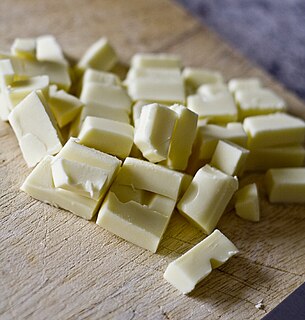
Mars is a variety of chocolate bar produced by Mars, Incorporated. It was first manufactured in 1932 in Slough, England by Forrest Mars, Sr. The bar was sold in two different formulations. In its original British version the bar consists of milk chocolate surrounding caramel and nougat, developed to resemble the American candy bar known as the Milky Way, which had been introduced a decade earlier. An American version of the Mars Bar was produced which had nougat and toasted almonds covered in milk chocolate; later, caramel was added to the recipe as well. The American version was discontinued in 2002, though it has been revived for short runs since then.
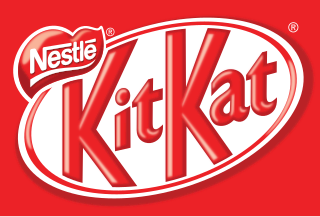
Kit Kat is a chocolate-covered wafer bar confection created by Rowntree's of York, United Kingdom, and is now produced globally by Nestlé, which acquired Rowntree in 1988, and closed it in 2006, with the exception of the United States where it is made under license by H.B. Reese Candy Company, a division of The Hershey Company. The standard bars consist of two or four pieces composed of three layers of wafer, separated and covered by an outer layer of chocolate. Each finger can be snapped from the bar separately. There are many different flavours of Kit Kat, including milk, white, and dark chocolate.
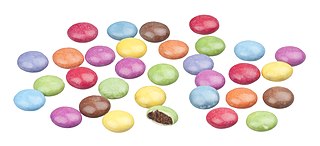
Smarties are a colour-varied sugar-coated chocolate confectionery. They have been manufactured since 1937, originally by H.I. Rowntree & Company in the UK, and are currently produced by Nestlé.
A White Knight is a chocolate-coated, chewy, mint-flavoured confectionery bar sold in Australia. It is manufactured by Nestlé Australia. The packaging is blue and white and features a picture of a knight on a horse. Its slogan is 'Mighty Mint Chew'.

Nerds are an American candy sold by Nestlé. Their unusual shape and thin candy-coating is comparable to rock candy. With their anthropomorphic covers, Nerds usually contain two flavors per box, and each flavor has a separate compartment and opening. Larger packages may contain various colors—sometimes referred to as "Rainbow Nerds". Smaller packages may contain either one flavor only, or one flavor with pieces of another.
Butterfinger is a candy bar created in 1923 in Chicago, Illinois by Otto Schnering, which currently is manufactured by Ferrero. The bar consists of a crispy peanut butter core coated in milk chocolate. Butterfinger has become known for its marketing and a roster of spokespersons, including Bart Simpson, Top Cat, Seth Green, Erik Estrada, Rob Lowe, and Jaime Pressly.

Aero is an aerated chocolate product manufactured by Nestlé. Originally produced by Rowntree's, Aero bars were introduced in 1935 to the North of England as the "new chocolate". By the end of that year, it had proved sufficiently popular with consumers that sales were extended throughout the United Kingdom.
Crunchie is a brand of chocolate bar with a honeycomb toffee sugar centre. It is made by Cadbury and was originally launched in the UK by J. S. Fry & Sons in 1929.

Magnum is an ice cream brand owned by the British/Dutch Unilever company and sold as part of the Heartbrand line of products in most countries. In Greece, the Magnum brand name is owned by Nestlé since 2005-2006 following the acquisition of Delta Ice Cream, so the Unilever ice cream uses the name Magic.

Coffee Crisp is a chocolate bar made in Canada. It consists of alternating layers of vanilla wafer and a foamed coffee-flavoured soft candy, covered with a milk chocolate outer layer. It is marketed by Nestlé.

The Milky Way bar is a chocolate-covered confectionary bar manufactured and distributed by the Mars confectionery company. Introduced in 1923, the Milky Way bar's American version is made of caramel and covered with milk chocolate, similar to the Mars bar sold outside of the U.S. The global Milky Way is a different chocolate candy bar similar to the American 3 Musketeers.
Mr. Big is the largest sized candy bar produced by Cadbury in Canada, hence the name. The standard bar is made of a layered vanilla wafer coated in caramel and rice crisps and covered in a chocolate coating. Because of Canada's higher chocolate standards compared to other areas of the world, it is not considered a "chocolate bar" and is labeled instead as a "candy bar". The bar is the length of two "standard"-sized bars – around 20 centimeters long. Additional varieties include Mr. Chew Big, Mr. Big Fudge, and Mr. Big with Maple.
The Wonka Bar is both a fictional candy bar, introduced as a key story point in the 1964 novel Charlie and the Chocolate Factory by Roald Dahl, and a type of consumer product candy bar inspired by the fictional confection. Wonka Bars appear in both film adaptations of the novel, Willy Wonka & the Chocolate Factory (1971) and Charlie and the Chocolate Factory (2005), and the play Charlie and the Chocolate Factory the Musical (2013) each with different packaging.

Oh Henry! is a candy bar containing peanuts, caramel, and fudge coated in chocolate.
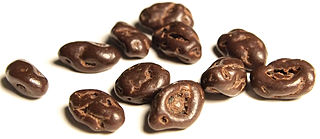
Chocolate-covered raisins are a popular bulk vending product. They consist of raisins coated in a shell of milk, dark or white chocolate. They are an item typically found at concession counters. Supermarket chains also sell them in bags and they were traditionally sold by weight, from jars, in candy stores.
Big Turk is a candy bar manufactured by Nestlé Canada, that consists of dark magenta Turkish delight coated in a chocolate coating. The 60-gram bar contains 4 grams of fat, which is advertised as 60% less fat than the average chocolate bar. It is typically found in a red, white, and blue striped package. The ingredients in the big Turk include sugar, glucose, modified corn starch, cocoa butter, milk ingredients, unsweetened chocolate, black carrot concentrate, soy lecithin, natural flavor, citric acid, salt. Even though peanuts are not an ingredient it is advised that the bars come in contact with machinery that also processes peanuts.

Nestlé Crunch is the name of a chocolate bar made of milk chocolate with crisped rice mixed in, produced by Nestlé. Nestlé Crunch was first introduced to market in 1928. Its current slogan is, "Munch Now. Munch Some Later." Its competition is the Krackel bar, which was introduced by The Hershey Company in 1938.
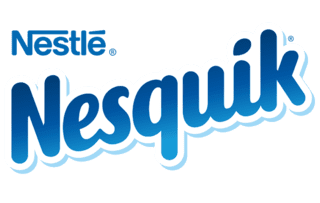
Nesquik is a brand of products made by Swiss company Nestlé. In 1948, Nestlé launched a drink mix for chocolate-flavored milk called Nestle Quik in the United States; this was released in Europe during the 1950s as Nesquik.


